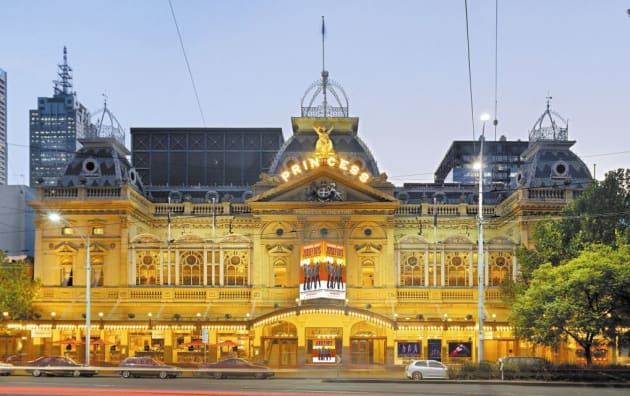GREAT THEATRES
The Princess Theatre, Melbourne

The Princess is Melbourne's oldest theatre – if you date it from the first building that claimed the site. Before the present theatre appeared on Spring Street near Parliament House, the area was occupied by Astley's Amphitheatre, which opened in 1854. This was made of brick and corrugated iron, and consisted of a central ring for equestrian entertainment and a stage at one end.
The amphitheatre was remodelled and renamed the Princess's Theatre and Opera House in 1857 by the new owner, George Coppin, an English-born actor and entrepreneur who was a large figure in Australian theatrical life. After his ownership the theatre changed hands almost yearly, and in 1865 was remodelled yet again. Though a popular theatre, it closed in 1885 due to poor attendances. There was a lot of competition between theatres at the time.
The Princess was very quickly reawakened. James Cassius Williamson, an American actor who first visited Australia under contract to Coppin, had formed a business partnership with George Musgrove and Arthur Garner that came to be the founding management team of JC Williamson, the legendary theatrical organisation. These men decided to build a new theatre on the site. In a mere nine months and at the cost of £50,000, the old building was demolished and replaced with the new Princess Theatre (the same year as Her Majesty's Theatre in nearby Exhibition Street was built). It opened with a performance of The Mikado.
The architect was St Kilda-born William Pitt (1855-1918), who was highly sought-after during Melbourne's land boom of the time. Though many of his buildings have since disappeared, those that remain are among the most ornate and grand in the city. They include the celebrated Rialto and Olderfleet buildings in Collins Street, the former Stock Exchange in Collins Street, and the Saint Kilda Town Hall. He was also responsible for the design of the Wellington Opera House in New Zealand. The Princess's opulence is indicative of its times, when the city was dubbed "Marvellous Melbourne" and bursting with riches from the gold rush.
Designed in the French Second Empire style, the theatre is made of rendered brick and has a slate roof and Mansard domes crowned with lacy cast iron cresting. The facade has a pediment containing the British coat of arms, surrounded by lions and topped with a figure of Fame.
Pitt was renowned as specialist in theatre interiors, and the Princess is testament to his taste, with its curving marble stairways and foyer, decorated ceilings and exquisite stained-glass windows (added later). The theatre's most impressive feature at the time it was built was the roof, which could be rolled back for ventilation.
The next major renovations to the theatre took place in 1920, and for this job another significant theatre designer was enlisted. New Zealand-born Henry White designed over 130 theatres in his lifetime, including Sydney's ornate State and Capitol theatres, Brisbane's Tivoli, Wellington's St James Theatre and the interior of Melbourne's Athenaeum. For the Princess he replaced the columns supporting the dress and upper circles with cantilevered balconies, turned the shops incorporated into the front of the theatre into a street level foyer, and installed the present copper awning.
By 1986 the theatre was again rundown. It was acquired by David Marriner (who also owns Melbourne's Forum, Comedy and Regent theatres). Once again the Princess was refurbished and brought up to date. The height of the proscenium was raised, the 19th century stage equipment was replaced and modernised and a new fly tower was built.
Thus brought up to date, the Princess Theatre reopened in 1989 with Les Miserables. This was followed by Phantom of the Opera, which established a new record for the longest running show staged in Victoria.
The “Prinny” seats nearly 1500 and boasts a plush red and gold interior and a beautiful central dome and chandelier. It is one of the most resplendent examples of historic architecture in the city and is a proud jewel among Australia's theatres.
– KAREN VAN ULZEN
This is an article from the Dance Australia archives. It was written for a series on 'Great Theatres' of the world.


